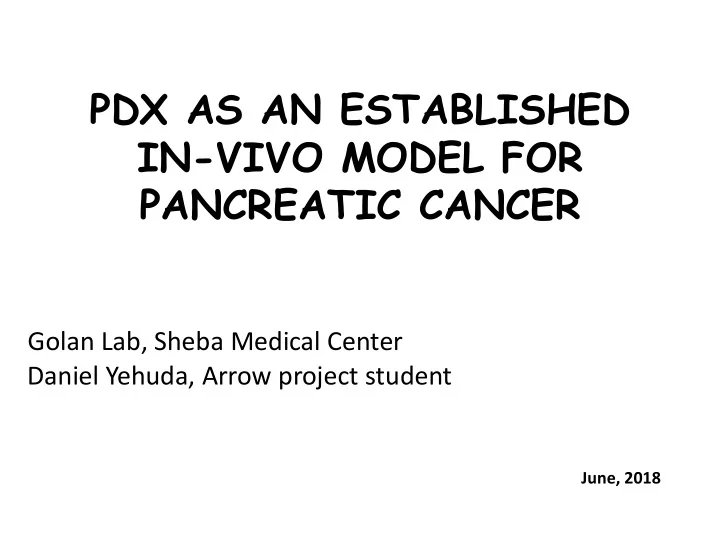

PDX AS AN ESTABLISHED IN-VIVO MODEL FOR PANCREATIC CANCER Golan Lab, Sheba Medical Center Daniel Yehuda, Arrow project student June, 2018
Targeted Treatment- pharmacology Experiment the Appropriate new drugs and treatment for the Well therapy individual patient Established Representing Model Disease biology New Targets
The model PDX IN-VIVO MODEL FOR PANCREATIC CANCER
What was the alternative? “When evaluating our approach to target discovery, we should consider if our current, powerful genomic technologies are being used on model systems that have poor clinical predictive power(…) (…) The selective pressure of cell culture allows the least differentiated cells to thrive, resulting in distinct and irreversible losses of important biological properties ” Patient-Derived Tumor Xenografts: Transforming Clinical Samples into Mouse Models Despina Siolas and Gregory J. Hannon 10.1158/0008-5472.CAN-13-1069 Published September 2013
My Project Aims • To further assist in the establishment and characterization of the PDX model as a preclinical model “mimicking” pancreatic cancer. • To develop a pancreatic cancer clinical data base that will enable a translational study in the future • To investigate the correlation between the clinical disease course and the PDX model characteristics.
PDX model and its Clinical Correlations hypothesis • The PDX model is a preclinical model that “mimics” pancreatic cancer (Morphologically and gnomically). • We gather data regarding 4 aspects: – In-Vivo model – Clinical data – Histological characteristics – Genomic characteristics • Hypothesis: the model characteristics correlate with the biological features and the clinical course of the disease.
Core needle biopsy PDX (Liver metastases) 73.2 1600 86.2 87.2 90.1 Tumor volume (mm 3 ) 99.2 1200 105.3 116.3 144.1 800 400 0 0 30 60 90 120 150 180 Days post cell injection
Methods • Histologically classified 47 first generation PDX. • We created a clinical data base.
Clinical data base • Diagnosis- date, stage • Treatment- dates, reaction to treatment, surgery, type of treatment • Past medical history and co morbidity • Well being- He • hight, weight, sleeping habits • Habits- alcohol use, drug use, physical activity • Family history • BRCA status • Overall survival • Metastatic disease survival
PDX model and its Clinical Correlations Methods- Clinical Aspect
Introduction- PDAC
PDX model and its Clinical Correlations Methods- Histological Aspect B. Ascites/pleural PDX – F1 generation Patients clinical samples Masson’s Liver biopsy Cell block HLA H&E trichome Pt. 86 Pt. 87
PDX model and its Clinical Correlations Methods- summary
Methods • 47 patients > Xeno 1 PDX’s. • Minimal tumor volume of 1000 mm*3.
The population 49 PDX’s of 47 Pts. 39 PDX’s 10 PDX’s In Vivo Growth reached excluded minimal volume 37 PDX’s of 37 In Vivo Growth 2 Mice – different pts. kinetics. 7 Pt. alive with clinical course 30 Pts. Died disease (AWD)
The population Clinical Aspects BRCA Status Stage At Diagnosis n=37 n=37 3 4 10 BRCA IIB BRCAness 19 III NOT TESTED IV 6 WT 30 2 Stage at diagnosis Median OS median time of (Months) metastatic disease (Months) IIB 28 13 13.50 III IV 6.5
The population In- Vivo Aspects Tissue Origin Clinical Time of Tissue Acqusition n=37 25 20 1 1 4 As 1 14 7 Liver 15 Pancreas 1 Mesenterium Liver 10 Pancreas As 10 12 17 5 PE 2 0 Resistant Naïve
Limitations • PDX’s that underwent sacrifice before reaching the minimal size. • Different cell number in the first injected tumor tissue/cells. • Different tissue origin.
Objectives • To investigate the correlation between the clinical disease course and the PDX model characteristics (histologic & In vivo growth) – Time to sacrifice vs. Overall survival – Does Necrosis (%) correlate with Time to sacrifice? – Does glands forming cells (%) correlate with Time to sacrifice? – Does Stage at Diagnosis correlate with the spread level in PDX (invasive/remote)?
Results Averge Time to Sacrifice vs. % of Necrosis 120 100 Average Time to sacrifice 80 60 40 20 0 50 > 50 26-50 11-25 10 < % of necrosis
Results Average Time to Sacrifice vs. % of Glands forming cells 140 120 Average Time to Sacrifice 100 80 60 40 20 0 75 > 50 > 50 25 < of Glands forming cells %
Results Metastatic disease survival vs. Time to Sacrifice Ascites Origin Metastatic disease survival (months) 40 35 30 25 20 15 10 5 0 0.00 20.00 40.00 60.00 80.00 100.00 120.00 140.00 160.00 180.00 200.00 Time To Sacrifice (days)
Results Metastatic disease survival vs. Time to Sacrifice Liver Origin 30 Metastatic disease survival (months) 25 20 15 10 5 0 0.00 50.00 100.00 150.00 200.00 250.00 300.00 Time To Sacrifice (days)
Results Stage at Diagnosis vs. spread In-vivo 35 30 25 num. of PDX’s 20 15 10 5 0 IV III IIB Stage at diagnosis no spred locally invasive involved Lymph nodes
In the future • We need to expand our cohort . • Automatization of our histologic characterization is the next point to investigate.
Thank you! Dr. Talia Golan Arrow Project Dikla Atias Sharon Halperin Prof. Anat Achiron Maria Raitses-Gurevich Mrs. Yaffit Rot Yulia Glick-Gorman Sally Zisman Dr. Michael Schvimer, Pathologist Liat Ashkenazi
Recommend
More recommend